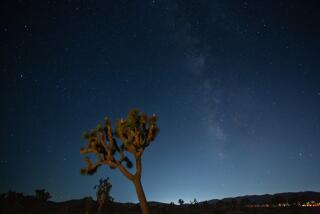Mind Over Matter: Symphony of Light and Sound : Astronomers at Arizona’s Kitt Peak Have Front-Row Seats to Galactic Performances : SCIENCE FILE: An exploration of issues and trends affecting science, medicine and the environment.
- Share via
KITT PEAK, Ariz. — It’s snowing starlight, and the telescopes here are lapping it up. Like children with their tongues stretched out to catch an icy crystal, astronomers are trying to intercept signals as they fall from the sky in a bewildering variety of forms.
The trouble is, the teeming population of the universe comes decked out in too many bells and whistles, all commanding attention at the same time. They roar in radio frequencies, shriek in ultraviolet, sparkle in visible light, whisper in the infrared. Some do all at once, sending out symphonies of light and sound.
The Kitt Peak astronomers see stars in every imaginable stage of development, from conception to death, in every shade from brilliant blue to brownish red, every size from pipsqueak to giant. They see galaxies forming, mating, devouring each other and disappearing without a trace. They see--or try to see--an infinite variety of exotica, including quasars, pulsars and black holes.
“There’s a rumor going around that we know what’s going on in the universe. And that’s plain wrong,” says astronomer Chris Impey of the Steward Observatory. “It’s kind of embarrassing. We tell the public that we’re looking out at the edge of the universe and then we find another galaxy right in front of our faces.”
The problem, explains Impey, is that scientists can only look for what they know how to see. In taking the cosmic census, “we only count what looks like us, like the Milky Way, or Andromeda.”
But the most common sort of galaxies, he suspects, are not like ours at all. Based on preliminary surveys, the astronomer thinks the great majority of galaxies are puny, weedy, diffuse and faint. “This subterreanean population of galaxies doesn’t get included” in the census.
Another mystery that’s been keeping them up at night is the strange disappearing act of the faint blue galaxies. Known collectively as “the wallpaper,” they crowd the deep sky that lies 5 billion years out into space and time--when the universe was only a third of its present age. About 150,000 pave each patch of space the size of the full moon. But when astronomers zoom closer to the present, the multitude are gone.
“Where did they go?” asks Kitt Peak Deputy Director Richard Green. “Did they burn out? Merge to form larger systems?”
One intriguing solution may come from the answer to yet another seemingly unrelated mystery that the astronomers would love to solve: What lies at the center of our own galaxy? For a long time, astronomers have speculated that this star- and gas-shrouded region might harbor a black hole.
Clearly, something supermassive is holding the center of the galaxy in a deathlike grip. If that something is a black hole, say astronomers, it’s very shy. It doesn’t send out the kind of X-ray signal one would expect. .
An alternative explanation, said astronomer George Ricke, would be a most peculiar population of stars. The scenario he’s come up with involves a complex choreography of two aging stars--a cosmic Rogers and Astaire.
The dance begins with a dwarf star orbiting a star rather like our sun. In its old age, the sun puffs up to a radius equal to the distance from our sun to Jupiter, and enfolds its companion in a permanent embrace. Then its atmosphere blows into space. What’s left is a stellar cinder and a stellar core. An odd couple indeed.
Enough of them could account for the center’s hold on the rest of the galaxy. As a plus, they might account for the disappearance of the faint blue galaxies. For example, it’s possible that the faint blue galaxies evolved into whole populations of cinder pairs, too dim to be seen anymore with Earth-bound telescopes.
Of course, what’s possible to see is changing daily, especially on Kitt Peak. At the nearby Steward Mirror Lab, researchers spin out enormous new eyes in rotating furnaces, the better to see the universe. Some new telescopes will pair two mirrors for a combined vision even sharper than Hubble’s.
The white-domed family of scopes on the mountain has been joined by a brash young prodigy. Known as WIYN (for its sponsors: Wisconsin, Indiana, Yale and the National Optical Astronomy Observatories), it includes adaptive optics that can take the twinkle out of starlight. WIYN is already producing sharper images than those of its elders.
No wonder the astronomers have stars in their eyes.
More to Read
Sign up for Essential California
The most important California stories and recommendations in your inbox every morning.
You may occasionally receive promotional content from the Los Angeles Times.













